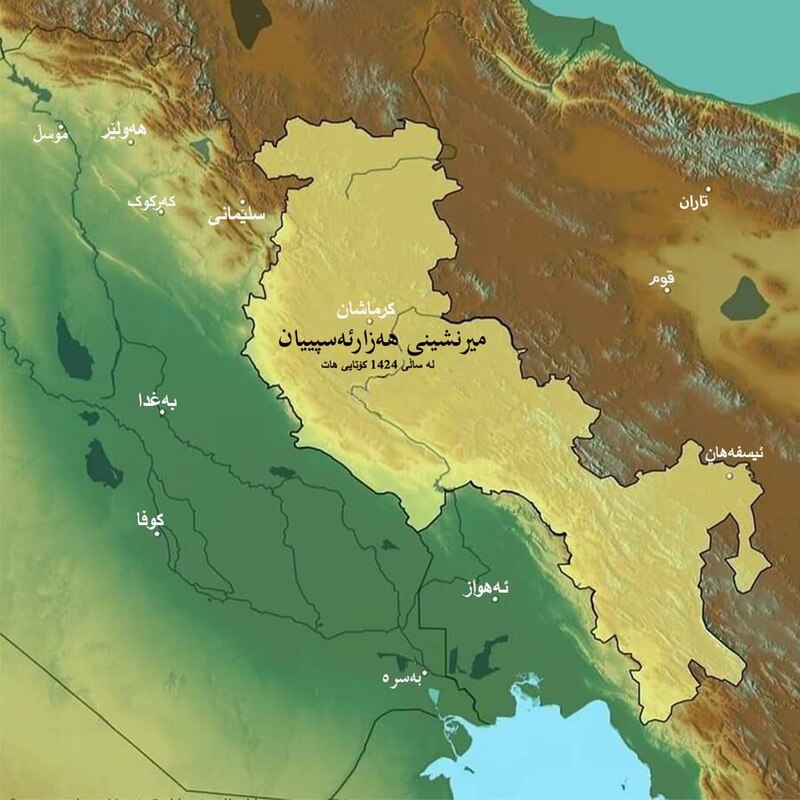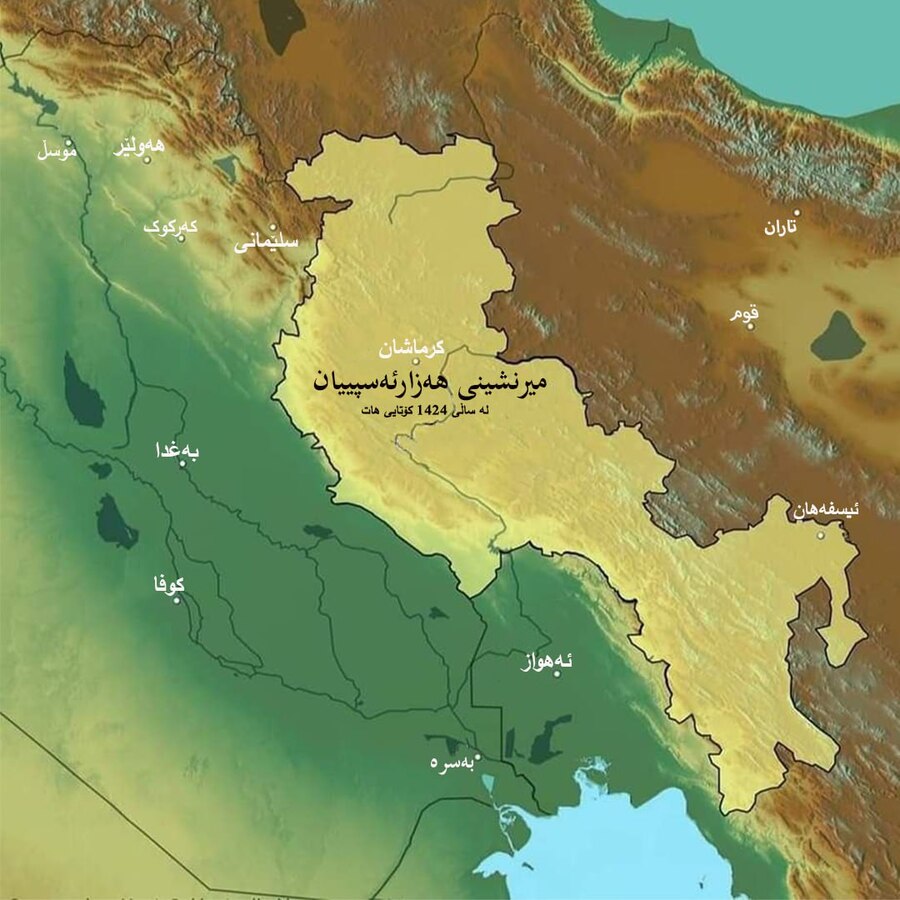The Great Atabaks of Lorestan or Hazar Aspian or Bani Fadluya (Fadlawayh) is the name of a dynasty that ruled Lorestan and western Khuzestan during the Seljuk period for nearly 300 years (550 to 827 AH or 1155 to 1424 AD). The title "Atabak", which means grandfather in Turkish, was given to emirs during the Seljuk period who were entrusted with the political education of their princes and received the rule of a region named after the prince under their education. But in those days when the Seljuk power was in decline, any emir and leader who could get territory and secure power for himself, gave himself that title, without being responsible for the education of any prince.
The Great Lori Atabaks ruled and got in power in this way. "Abu Tahir" was the founder of the chain of power that had previously served the Atabaks of "Salghori". The Salghori were a tribe of Oghuz Turkmen who had settled in Khorasan with the rise of Togrul, the founder of the Seljuk dynasty, but they invaded Persia in southern Iran with the decline of the Seljuk rule. They established their rule under the name of the "Salghori Atabaks", centered in Shiraz.
According to the historian Hamdallah Mustawfi, the origin of the great Atabaks of Lorestan goes back to the Kurds living in Sham (Syria). Ghaffari, another historian who has worked on the great Atabaks of Lorestan, similarly traces their ancestry back to Syrian Kurdistan and believes they were of the blood of the legendary Iranian king Kay Khosrow. After some of his relatives were killed by the Syrian authorities, Ibrahim (Brayim son of Ali) and his tribe moved to Silwan or "Miafarqin" near "Diyarbakir", but later "Kinoya", the son of Ibrahim, took revenge on the Syrian ruler. Then they went with their tribe to Azerbaijan and then to Gilan. After Kinoya, his cousin Makki, son of Abul Hassan, succeeded him, took his tribe to Lorestan, and settled there. Later, Abu Tahir, one of the children of Makki son of Abul Hassan son of Fadlawayh, went to the Atabaks of Salghor in Fars. Because of his courage and skills, he became a leader and was sent by the Selghori Atabak to fight the Kurdish Shwankara in Persia and succeeded. After this victory, Abu Tahir went to attack Lorestan on his request and order of the Atabak, and on the pretext that he was occupying Lorestan for the Atabak of Salghori, he took the army there. But after the victory, he no longer bowed to the orders of Atabak and declared his independence. After 34 years of rule, his son "Nusratuddin Hazar Asp" succeeded his father and appointed the city of Izej (Izeh) as his capital.

Hazar Asp was a wise and skilled ruler who developed cities and attracted the attention of the rest of the Lorestan and Arab tribes. Tribes such as Aqeeli, Hashemi, and Bakhtiari came to Lorestan from Jabal al-Samaq and helped Hazar Asp in development. Hazar Asp extended his territory near Isfahan, fought against the Persian Atabaks and occupied some of their territories.
Along with the Mongol invasion, Hazar Asp proposed to Sultan Jalaluddin Kharazmsha to go to Kurdistan and make the Kurdistan mountains stronghold, but the Sultan refused, although they were relatives and the daughter of Hazar Asp was Sultan's sister-in-law.
However, when Sultan Jalaluddin went to Baghdad, Hazar Asp warmly welcomed him. After Hazar Asp, his son Emadaddin succeeded him, whose rule lasted for about twenty years and was respected by the Abbasid Caliph. After Emadaddin, Tokla, another son of Hazar Asp succeeded his father and brother. Although Atabak Saad, one of the Persian Atabaks of Salghor, attacked Tokla three times, he did not defeat him and as a result, Tokla's power became stronger. It should be noted, however, that Tokla was granted Atabak authority by the Abbasid Caliph. Tokla was very sad about the killing of the Caliph by Holako Khan and refused to surrender to Holako Khan although he had previously fought with Holako Khan, he left the Mongol camp and returned to Lorestan after the killing of the Muslims and the Caliph. On the orders of Holako, Tokla was arrested and taken to Tabriz where he was killed. Tokla's reign ended in 656 AH.
Then, on Holako's orders, Tokla's brother Shamsaddin Alb-Arghun became the successor. To compensate for the Mongol decision, Shamsaddin did not collect taxes from the people for several years and made great efforts for prosperity and development. His son Yusuf Shah succeeded him and helped Abaqa Khan (the Mughal king) and maintained his power too. Once Abaqa Khan was captured, he rescued him and was given the title of "Bahadur" by Abaqa Khan. Abaqa Khan also gave him authority over the Kohgiluye and the Golpayegan regions and respected him.
After Abaqa Khan, Yusuf Shah remained in the power of his successors, "Takudar" and "Arghun". After Yusuf Shah, his son Afrasiab succeeded him. Because during his reign in Lorestan, the Mongol power weakened, Afrasiab hoped for the rule of the whole of Iran and tried well, but failed. He was later killed by the Ghazan Khan Mongol for his attempts to seize power. After Afrasiab, his brother Nusratuddin Ahmad succeeded him, whom most historians praise for his skill, efficiency, and courage, and call him the apple of the eyes of (Qara al-Ain) of the ruling chain of the great Atabaks of Lorestan.
He reigned from 695 to 733. Yusuf Shah II and Afrasiab II were two other rulers of the Atabaks of Lorestan. After Afrasiab II, his son Noorulward took power, but he got involved in the conflict between the Atabaks of the Inju dynasty and the Atabaks of the Muzaffar dynasty (who were fighting over the state of Persia) and sided with the Inju dynasty. Therefore, the Atabaks of Muzaffar attacked Nurulward and captured him, and blinded him by one of his blood relatives (cousin, or nephew, three historians wrote differently) named Shamsaddin Pashang. Shamsaddin became Atabak and ruled for thirty years. He was succeeded by his son Pir Ahmad, who according to historians, was the time of the destruction of the great Atabaks of Lorestan. He kills one of his brothers, and the rest of his brothers turn away from him.
With the arrival of Timur, submitted to him, but Timur made one of Pir Ahmad's brothers his power partner, which led to another war between the brothers. Pir Mohammad, the descendant of Timur, arrested Pir Ahmad Atabak and imprisoned him, but he escaped. When he returned, he began to kill people. He was killed by the Astarki tribe and his son Abu Saied became the Atabak of Lorestan with the support of Askandar, the descendants of Timur. After him, his son Shah Hussein succeeded him, but he was killed by one of his relatives, Ghiyasuddin son of Kavus, son of Hushang, son of Pashang. Ibrahim Sultan, a descendant of Timur, attacked Lorestan to revenge Shah Hussein, but Ghiyasuddin ran. After him, the rule of the great Atabaks of Lorestan or Bani Fadlawayh or Hazar Aspian ended forever and the power of the region fell to the Lori tribal chiefs of Bakhtiari.








